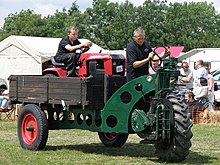
A semi-trailer truck, also known as a semitruck, is the combination of a tractor unit and one or more semi-trailers to carry freight. A semi-trailer attaches to the tractor with a type of hitch called a fifth wheel.

A road train, land train or long combination vehicle (LCV) is a trucking vehicle used to move road freight more efficiently than semi-trailer trucks. It consists of two or more trailers or semi-trailers hauled by a prime mover.
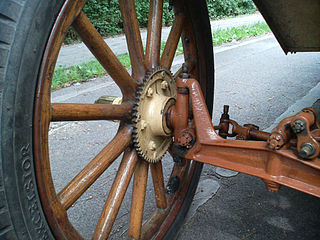
The kingpin is the main pivot in the steering mechanism of a car or other vehicle.
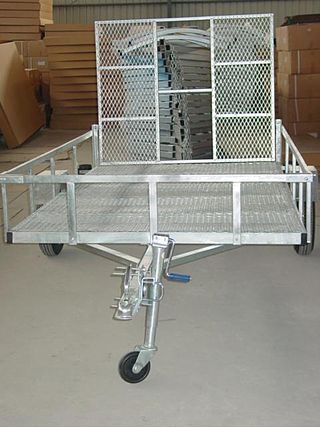
A trailer is an unpowered vehicle towed by a powered vehicle. It is commonly used for the transport of goods and materials.

A dump truck, known also as a dumping truck, dump trailer, dumper trailer, dump lorry or dumper lorry or a dumper for short, is used for transporting materials for construction as well as coal. A typical dump truck is equipped with an open-box bed, which is hinged at the rear and equipped with hydraulic rams to lift the front, allowing the material in the bed to be deposited ("dumped") on the ground behind the truck at the site of delivery. In the UK, Australia, South Africa and India the term applies to off-road construction plants only and the road vehicle is known as a tip lorry, tipper lorry, tipper truck, tip truck, tip trailer or tipper trailer or simply a tipper.

In the 1950s, LeTourneau Inc. developed several overland trains, essentially oversized semi-trailer trucks that could travel over almost any terrain. Their intention was to be able to handle logistics needs without being dependent on local road or rail systems, allowing them to operate in back-country areas. The US Army had three experimental units built, the largest reaching almost 600 feet (183 m) long, which holds the record for the longest off-road vehicle. Road trains are in use in certain roles today, but the US Army examples and a few derivatives appear to be the only off-road examples built.

A dumper or dumper truck or dump truck is a truck designed for carrying bulk material, often on building sites. A dumper has a body which tilts or opens at the back for unloading and is usually an open 4-wheeled vehicle with the load skip in front of the driver. The skip can tip to dump the load; this is where the name "dumper" comes from. They are normally diesel powered. A towing eye is fitted for secondary use as a site tractor. Dumpers with rubber tracks are used in special circumstances and provide a more even distribution of weight compared to tires. Continuous tracks allow the operator to carry heavier payload on slick, snowy, or muddy surfaces, and are popular in some countries.

Thornycroft was an English vehicle manufacturer which built coaches, buses, and trucks from 1896 until 1977.

A drive wheel is a wheel of a motor vehicle that transmits force, transforming torque into tractive force from the tires to the road, causing the vehicle to move. The powertrain delivers enough torque to the wheel to overcome stationary forces, resulting in the vehicle moving forwards or backwards.
Scammell Lorries Limited was a British manufacturer of trucks, particularly specialist and military off-highway vehicles, between 1921 and 1988.
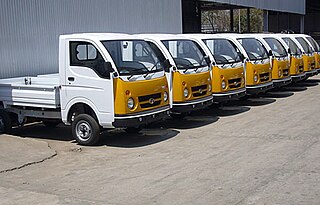
Tata Ace is a model of mini trucks manufactured by Tata Motors. It was launched in 2005.

Karrier was a British marque of motorised municipal appliances and light commercial vehicles and trolley buses manufactured at Karrier Works, Huddersfield, West Yorkshire, by Clayton and Co., Huddersfield, Limited. They began making Karrier motor vehicles in 1908 in Queen Street South, Huddersfield. In 1920, H.F. Clayton sold Clayton and Co's Huddersfield business into public listed company Karrier Motors while keeping their Penistone operation separate. Mechanical and electrical engineers Clayton & Co Penistone, remain active in 2020 as Clayton Penistone Group.

The Euclid Company of Ohio was a company that specialized in heavy equipment for earthmoving, namely dump trucks, loaders and wheel tractor-scrapers. It operated in the US from the 1920s to the 1950s, when it was purchased by General Motors. It was later purchased by Hitachi Construction Machinery.

A tank transporter is a combination of a heavy tractor unit and a mating full trailer or semi-trailer, used for transporting tanks and other armoured fighting vehicles. Some also function as tank recovery vehicles, the tractors of which may be armoured for protection in combat conditions.

The M25 Tank Transporter (G160) was a combination 6x6 M26 armored heavy tank transporter/tank recovery tractor and companion 40-ton M15 trailer introduced into US Army service in Europe in 1944–45. Manufactured by Pacific Car & Foundry Co., it was a substantial upgrade over the Diamond T M19 transporter/trailer duo introduced in 1940.

Tata Prima is a range of heavy trucks produced by Tata Motors, a wholly owned subsidiary of Tata & Sons of India. It was first introduced in 2008 as the company's 'global' truck. Tata Prima was the winner of the 'Commercial Vehicle of the Year' at the Apollo Commercial Vehicles Awards, 2010 and 2012. The 'HCV (Cargo) Truck of the Year, 2010' and the 'HCV (Rigid) Truck of the Year, 2012'. First truck range with Common rail engine, Automatic transmission, World-class cabin with HVAC, Air suspension driver seats, Data logger for performance tracking. The trucks have a combined loading capacity of 55 tonnes, ideal for heavy-duty shipment. The interior of the Prima is equipped with modern features like GPS, air conditioning, 4-way adjustable driver and co-driver seats, ADAS features like lane departure warning, driver eye monitoring system etc.

The Lister Auto-Truck was a small monowheel tractor built for moving light loads around factories, railway yards and similar sites. They were based on a design originally by Auto Mowers Ltd, and were built by R A Lister and Company of Dursley, Gloucestershire, well known for their range of small stationary engines. A narrow-gauge rail version of the Auto-Truck was made along similar stylistic lines as regards the bonnetted engine, and its light weight made it popular for temporary and lightly laid tracks such as used on brickworks, peat bogs, and construction sites. Production of both the Auto-Truck and the Rail-Truck extended from the 1920s to the 1970s.

The Mack M123 (G792) was a 10-ton 6x6 semi-tractor introduced in 1955; the Mack M125 was a heavy cargo truck version of the M123. The M123 was used to tow tank transporter trailers while the M125 towed field artillery pieces.
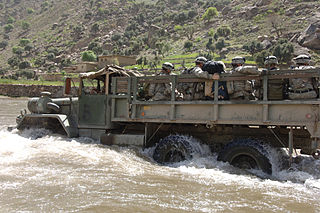
The M809 Series 5-ton 6x6 truck (G908) was a family of heavy tactical trucks built for the United States Armed Forces. The basic cargo version was designed to transport a 5-ton (4,500 kg), 14 ft (4.3 m) long load over all terrain in all weather. In on-road service the load weight was doubled. Built by AM General, they evolved into the M939 Series.

The AEC Roadtrain was a prototype road train designed by the British Overseas Mechanical Transport Committee and built by Leyland Motors and Associated Equipment Company (AEC) in the early 1930s to meet a British Army requirement for an offroad capable heavy transport vehicle to open up remote areas of the British Empire.


